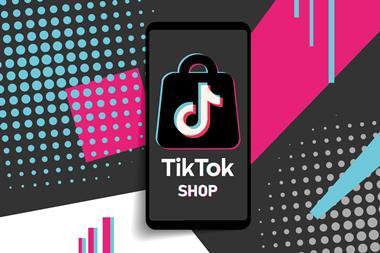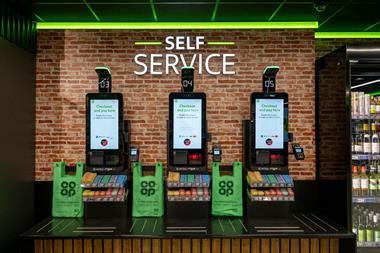Customers are becoming harder to entice, so once you get them in your store it is vital that you serve them quickly.
Tesco has been a big advocate of this principle, using thermal and imaging cameras to monitor customer numbers as part of its “one in front” commitment to queue busting. But it is not alone in its combined use of technology and staff to minimise waiting times.
Morrisons is introducing queue management technology to its stores to help ease queues at the tills. The i-QM system from Irisys is being rolled out across 300 of the grocer’s stores following a trial that cut queuing times by 5 per cent. The system uses infrared technology to record the number of shoppers entering stores and then compares that with the average length of a sale and the average time taken to serve shoppers at the store’s checkouts. Store staff can then calculate the number of tills that will be needed to serve them.
The system at Morrisons is similar to the Irisys system already deployed by Tesco. However, Irisys says that Morrisons’ version has been designed to use past data to self-learn when it comes to predicting queues, and also to help generate staffing forecasts that are based on customer service levels, as well as sales.
Morrisons head of retail operations Sylvia Jones says: “This is an exciting and innovative approach, which will deliver real benefits to all our customers and enable us to offer the best possible customer service to everyone who shops with us.”
Meanwhile, French home improvement retailer Castorama is using the StoreWorld Queue Busting system from Centric. The retailer, which is owned by Kingfisher Group, is using the solution in three of its stores, but Centric says that the retailer is planning a roll-out throughout the whole of France.
Castorama uses the system most at lunchtime, when there is a peak in visitor numbers. Staff pre-scan customers’ selected items while they are waiting in the queue and give each customer a card with a barcode. When they get to the till, the cashier scans the card and a receipt showing all pre-scanned products is generated. Additional products can still be added at this stage.
Earlier this year, Somerfield began trials of a similar system to speed up customer waiting times at its main tills at a Brighton store. The system allows staff to scan and bag baskets of shopping while customers are queuing. The grocer was also working with the system’s supplier, Datalogic, on a development that would allow it to be used for a bank of smaller tills that have a “snake queue”. It works by capturing details of multiple customers’ shopping and transferring the right individual’s data to the appropriate till as it becomes available.
Somerfield is understood to be happy with the results of this trial in terms of reducing queue lengths. However, the project is on hold while the company’s sale to the Co-operative Group awaits clearance from the Office of Fair Trading.
Elsewhere, US retailer Meijer has taken a different approach with the trial of its Grocery Express service, which launched last month. A cross between online and in-store shopping, the new service allows customers to select grocery and health and beauty items online, then drive to the store and have them delivered to their car at a designated time and location.
Shoppers select a scheduled collection time, which can range from three hours to seven days away. They can change their order up to three hours before picking it up and can postpone their arrival time if they’re running late. Meijer is charging US$6.95 for an individual order or customers can pay US$24.95 (£13.45) for a monthly subscription allowing unlimited orders. When the customer arrives, they call a phone number or push a button on the Grocery Express entry door to let staff know they have arrived.
Meijer vice-president of marketing and e-commerce Rob Fleener says: “People can shop online and three hours later they can pull up to the store and receive their order hand-delivered by a personal shopper. It’s a great convenience for customers.”
But supermarkets and DIY stores aren’t the only retailers getting in on the queue-busting act. John Lewis has installed a customer flow management system from Q-Matic in the children’s footwear departments at 21 of its stores. The retailer has just finished its first back-to-school season since the system went fully live and says that it is still analysing the figures to gauge how well the system performed. However, the system has been designed to not only reduce the time that parents spend waiting with their children to be served by an assistant, but also to allow them to book a slot using a kiosk and then go and browse the store without worrying that they will miss their turn.
When customers arrive in the department, they are advised to use a touchscreen kiosk to enter the child’s details. The system then allocates a suitable time slot, prints a ticket for the customer and sends a message to the pager of the staff member who will be serving them.
The aim is to set appointments with a maximum waiting time of 20 minutes. In addition, the staff member can record details of customer choices and any sales made on their pager to provide extra insight and improve stock availability.
A version of the Q-Matic system is also in use at new-design Vodafone stores and the mobile phone retailer is rolling out the system as part of its latest store opening programme. The system has been employed at the retailer to direct customers to the relevant member of staff to deal with different types of customer enquiry.
Vodafone head of retail development Jonathan Dryland says: “Two of the reasons we believe Q-Matic works so well is that it is supported by a front-of-house adviser – who gives a friendly greeting and gives customers the confidence to use the service – and it is a feature of our new store layout, which makes each store easier to navigate.
“Overall, the system gives control to the customer and the retail teams. Customers don’t have to worry about missing their turn and managers can organise teams according to where demand is. Using the information it provides, managers can ensure bottlenecks are far and few between because their team’s resource is focused where it is needed most at any one time, helping to keep customers happy.”
Vodafone has monitored customer satisfaction following the introduction of the system and says that 94 per cent of customers scored 7/10 or more when asked if the queuing system gave them some control over their time in store. However, this positive outcome is more than just a good result from a customer survey – it has also actively benefited Vodafone’s store staff. Dryland explains: “Retail advisers like it – they are more in control of the customer experience because it is fair and organised. Anything that helps to make their lives easier so that they can focus on the customer is always welcomed.”
The system also creates metrics, such as the number of people in a store at any one time, the number of different types of enquiries, average queue times and how many customers take a ticket but don’t wait for their slot. Vodafone says that it uses this data to ensure that the number of people who don’t bother to wait is minimised.
Dryland says: “All of this data can be collated by a store to plan how a team needs to be positioned in-store and by head office to ensure we have overall resourcing right, as well as regionally and divisionally. Together it all helps to ensure we pick up trends and respond to them quickly. A good example might be to ensure we’re getting things right across the country at our busiest times of year, like Christmas or on a Saturday when a new handset hits the market.”
Vodafone’s experience sums up how the adoption of technology can cut queues. Where they are used to complement staff rather than replace them, such systems and devices help to serve customers more quickly and keep them happy.


























No comments yet